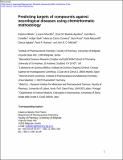Files in this item
Predicting targets of compounds against neurological diseases using cheminformatic methodology
Item metadata
| dc.contributor.author | Nikolic, Katarina | |
| dc.contributor.author | Mavridis, Lazaros | |
| dc.contributor.author | Bautista-Aguilera, Oscar M. | |
| dc.contributor.author | Marco-Contelles, Jose | |
| dc.contributor.author | Stark, Holger | |
| dc.contributor.author | Carreiras, Maria do Carmo | |
| dc.contributor.author | Rossi, Ilaria | |
| dc.contributor.author | Massarelli, Paola | |
| dc.contributor.author | Agbaba, Danica | |
| dc.contributor.author | Ramsay, Rona R. | |
| dc.contributor.author | Mitchell, John B. O. | |
| dc.date.accessioned | 2015-11-26T00:11:56Z | |
| dc.date.available | 2015-11-26T00:11:56Z | |
| dc.date.issued | 2015-02 | |
| dc.identifier | 158737015 | |
| dc.identifier | d8f6ca5d-4d4f-43d3-a0b9-df2e143777c2 | |
| dc.identifier | 84922105008 | |
| dc.identifier | 000348190700007 | |
| dc.identifier | 25425329 | |
| dc.identifier.citation | Nikolic , K , Mavridis , L , Bautista-Aguilera , O M , Marco-Contelles , J , Stark , H , Carreiras , M D C , Rossi , I , Massarelli , P , Agbaba , D , Ramsay , R R & Mitchell , J B O 2015 , ' Predicting targets of compounds against neurological diseases using cheminformatic methodology ' , Journal of Computer-Aided Molecular Design , vol. 29 , no. 2 , pp. 183-198 . https://doi.org/10.1007/s10822-014-9816-1 | en |
| dc.identifier.issn | 0920-654X | |
| dc.identifier.other | ORCID: /0000-0003-1535-4904/work/34907347 | |
| dc.identifier.other | ORCID: /0000-0002-0379-6097/work/34033388 | |
| dc.identifier.uri | https://hdl.handle.net/10023/7849 | |
| dc.description | The authors acknowledge financial support from the Scottish Universities Life Sciences Alliance (SULSA). OMBA and JMC thank MINECO (Spain) for a fellowship, and support (SAF2012-33304), respectively. KN and DA acknowledge project supported by the Ministry of Education and Science of the Republic of Serbia, Contract No. 172033. Further supports by Else Kroner-Fresenius-Stiftung, Translational Research Innovation—Pharma (TRIP), Fraunhofer-Projektgruppe fur Translationale Medizin und Pharmakologie (TMP) (to HS) and the European COST Actions BM1007, CM1103 (including STSM 10295 to KN), and CM1207 are also gratefully acknowledged. | en |
| dc.description.abstract | Recently developed multi-targeted ligands are novel drug candidates able to interact with monoamine oxidase A and B; acetylcholinesterase and butyrylcholinesterase; or with histamine N-methyltransferase and histamine H3-receptor (H3R). These proteins are drug targets in the treatment of depression, Alzheimer’s disease, obsessive disorders, and Parkinson’s disease. A probabilistic method, the Parzen–Rosenblatt window approach, was used to build a “predictor” model using data collected from the ChEMBL database. The model can be used to predict both the primary pharmaceutical target and off-targets of a compound based on its structure. Molecular structures were represented based on the circular fingerprint methodology. The same approach was used to build a “predictor” model from the DrugBank dataset to determine the main pharmacological groups of the compound. The study of off-target interactions is now recognised as crucial to the understanding of both drug action and toxicology. Primary pharmaceutical targets and off-targets for the novel multi-target ligands were examined by use of the developed cheminformatic method. Several multi-target ligands were selected for further study, as compounds with possible additional beneficial pharmacological activities. The cheminformatic targets identifications were in agreement with four 3D-QSAR (H3R/D1R/D2R/5-HT2aR) models and by in vitro assays for serotonin 5-HT1a and 5-HT2a receptor binding of the most promising ligand (71/MBA-VEG8). | |
| dc.format.extent | 16 | |
| dc.format.extent | 2406873 | |
| dc.language.iso | eng | |
| dc.relation.ispartof | Journal of Computer-Aided Molecular Design | en |
| dc.subject | Multi-targeted ligands | en |
| dc.subject | Circular fingerprints | en |
| dc.subject | Off-target study | en |
| dc.subject | ChE | en |
| dc.subject | MAO | en |
| dc.subject | Histamine H3 receptor | en |
| dc.subject | HMT | en |
| dc.subject | QR Microbiology | en |
| dc.subject | QA76 Computer software | en |
| dc.subject | R Medicine (General) | en |
| dc.subject.lcc | QR | en |
| dc.subject.lcc | QA76 | en |
| dc.subject.lcc | R1 | en |
| dc.title | Predicting targets of compounds against neurological diseases using cheminformatic methodology | en |
| dc.type | Journal article | en |
| dc.contributor.institution | University of St Andrews. School of Chemistry | en |
| dc.contributor.institution | University of St Andrews. Biomedical Sciences Research Complex | en |
| dc.contributor.institution | University of St Andrews. EaSTCHEM | en |
| dc.contributor.institution | University of St Andrews. School of Biology | en |
| dc.identifier.doi | https://doi.org/10.1007/s10822-014-9816-1 | |
| dc.description.status | Peer reviewed | en |
| dc.date.embargoedUntil | 2016-02-01 |
This item appears in the following Collection(s)
Items in the St Andrews Research Repository are protected by copyright, with all rights reserved, unless otherwise indicated.

